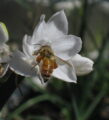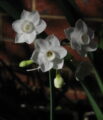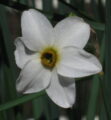Thanks everyone for the photos and reports and congratulations to John Reed.
Way back in 1999 some N. broussonetii seed generously sent to me by Harold Koopowitz was sown. Now, after 20 years waiting, it has finally flowered. Either it is unusually attractive to insects or I have been admiring it a lot.
I doubt that it is so very difficult. I think it is the most frost sensitive of daffodils and a few years were lost for that reason. One summer it was watered early and it didn’t sprout at all. So my advice is protect it from frost and keep it dry until autumn.
The same forcing method that was used on the tazettas (daffnet.org/2019/02/first-flowers-downunder/) was also applied to some N. broussonetii paperwhite hybrids . A few responded a little but 07_01W (from Bill Welch seed), now Autumn Quartz , was not one of them. These hybrids have slight to no fertility for me which suggests broussonetii and paperwhites are not that close.
Of the Gramons ‘Gramonite’ has responded best to forcing, and of the paperwhites, a vevy nice form of N. pannizianus (from Michael Salmon seed). Gramonite may prove to be a good parent.
Another delight from Harold’s seed has been his N. miniatus. This only took 7 years. A few tiny offsets from 2 year olds were distributed and others flowered them quicker, so clearly my cultivation was not as good as it might have been.
These have slight streaks in them. I will be especially delighted if they are related to Harold’s striped ones.
daffnet.org/2014/10/daffodil-flag-flying-8/
Harold reported on the fertility of a miniatus tazetta cross here.
In 2017 some seed from a similar cross were sown and, astonishing to me, they have flowered in their third year. This is the first time a tazetta has done this for me.
These too have significant fertility but unfortunately none set seed this year. Hopefully there will be some seed from it as a pollen parent.
Another interesting result has been the hybrid between the elegans hybrid Anza and the very nice paperwhite 03_01W. N. elegans orange is sunproof but in the paperwhite hybrid the orange fades. I take this to be a similar type of cross to ‘Stars’ or ‘Straws’ and like those plants it is highly sterile. This is not too surprising given the different chromosome numbers. But triploids of these types of hybrids can have fertility. Some more of the Gramons (WTT) x tazetta (TT) seedlings have flowered and some of these are diploid (TT) enough and odd enough to suggest that paperwhite can be reconciled with the other tazettas. I dream that fertile reverse bicolor tazettas are possible.
Meanwhile tazettas from Bill Welch seed have been flowering gloriously.
N. viridiflorus has been flowering for a while. A couple of its fertile intersectional hybrids seem to consistently flower at least as early if not earlier than it does.
A surprising viridiflorus hybrid has come from the 8W-O elegans hybrid tazetta Tanz x viridiflorus. This flower remains green throughout its life. It is surprisingly similar to viridiflorus itself but unfortunately highly sterile.
Unfortunately it is probably too late now to pollinate tazettas because there is not enough time for them to produce seed before winter. But not to worry, along with the viridiflorus hybrids the bulbocodiums have begun.














